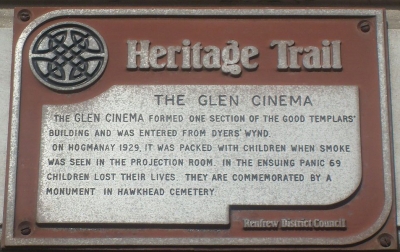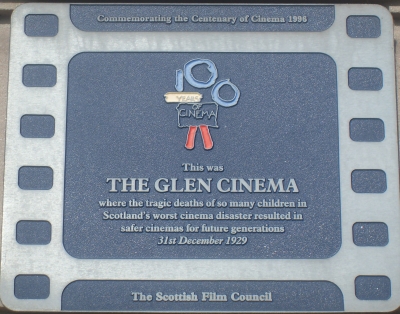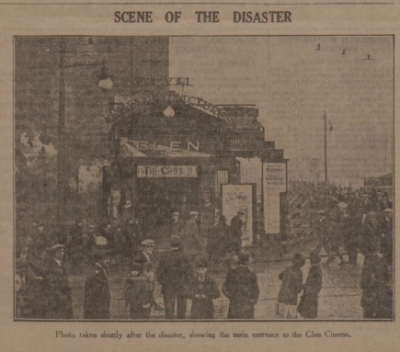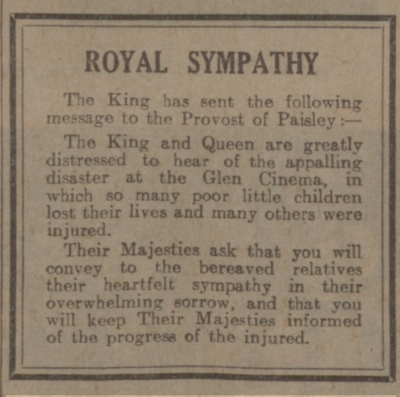On 31 December 1929, Hogmanay, seventy-one children died and more than fifty were injured when young cinema-goers panicked after thick smoke billowed around the darkened auditorium during a children’s matinee performance of The Dude Desperado at the Glen Cinema, Paisley, Scotland. Calls of ‘fire’ prompted terrified children to flee towards the exits.

Survivor Sadie Elias said she had chosen the Glen Cinema as it had the most gory and bloodthirsty film, the day’s events, however, would outstrip any Hollywood movie. Hundreds of children were at the packed cinema and some reports stated close to one thousand, and many had earned the coppers needed for the price of the entry by returning jam jars and the like to their local stores. The Dude Desperado, a Western, was shown before the main feature film The Crowd. Many children were in the cinema that day to get out from under their mothers’ feet as they readied their homes for the Hogmanay celebrations.
Minutes before disaster, the projectionist changed the thousand-foot reel of flammable nitrocellulose film as was the norm, half-way through the showing. His fifteen-year-old assistant, James McVey, carried the reel of film in its can to the Rewind Room. He placed the can on an accumulator battery and once the film was rewound, placed the reel in the can causing a short-circuit. Within seconds, the film was smouldering, and McVey, realising the danger, tried to remove it from the building.
Finding the nearest exit jammed, he dropped the still-smouldering reel in the hallway, giving the smoke further opportunity to creep its way around the building and ran to the projectionist’s room, unable to leave his station, the projectionist advised informing the manager. Alerted, the manager forced the door open and kicked the film can outside. But by then, acrid smoke and noxious fumes had spread into the auditorium and while it billowed the children in the cinema panicked.

They ran in all directions searching for a way out, many headed to a staircase leading down to the door that exited onto Dyers Wind, an alleyway at the back of the cinema. The door opened inwards and the ensuing stampede behind meant that it couldn’t be opened easily. The door was not only hard for the children to open but was also secured from the outside with a padlocked iron concertina gate which trapped the suffocating youngsters inside. Many children died at this point, the youngest only eighteen-months-old, bodies trampled and crushed, piled one on top of the other, some died standing up fingers gripping the gate. The rescuers, when they arrived, met with harrowing scenes.
Word of trouble spread fast and soon police, firemen and members of the public rushed to help the stricken children. Crowds gathered outside, at first unaware of the horror unfolding inside. Anguished parents headed for the cinema and the Royal Alexandra Infirmary in a desperate search for good news. Later, newspapers would sombrely report, ‘a holocaust occurred this afternoon’.
Peter Smith, watching the other children race for the exits, some jumping from the balcony above, headed to the toilet where he knew there was a window. Helped by others steadying him from behind, he climbed onto the toilet pan and kicked at the window until the glass smashed. Then a policeman’s hand grabbed his boot and stopped him going further and warned him to steer clear while he used his truncheon to remove shards of glass. He was then helped through the window along with the other children that had followed him into the toilet.
Some children, gaining strength born from their desperation, managed to pull a door off its hinges in their frantic efforts to escape.
There were not enough ambulances to convey all the dead, injured and dying children to the hospital and trams were requisitioned to take them there, others were driven in private motor cars that happened to be in the area at the time.

Ten-year-old James Reilly was caught up in the crush having been at the cinema with his friends. He was believed to be dead and taken to the mortuary. However, a passing nurse noticed a ‘flicker of life’ and resuscitated him, awakening briefly, with the nurse ‘pumping away at his chest’, he remembered seeing other children’s bodies lying in the mortuary before losing consciousness again.
One mother, not realising the enormity of the situation cuffed her son around the ear for returning home with only one shoe, having lost the other in the scramble for safety.
The horror that occurred in Paisley that New Year’s Eve reverberated around the world and dramatic headlines informed readers of the devastating death toll, it became known as the Black Hogmanay. A relief fund quickly amassed more than £5,000.
All the dead children’s death certificates stated asphyxia caused by crushing. Survivor Peter Smith said ‘it was a fire that was never a fire’.

Some families lost more than one child, the McEnhills lost three children; two sons, James and Edward, and a daughter, Margaret. All three were buried together. The Kilkies, who lived in the same street as the McEnhills, lost two children. One gravedigger buried two of his children, another gravedigger, one. The majority of funerals took place on 4 January 1930, a bleak Saturday, flags flying at half-mast in the town.
In the aftermath, it became clear that less that two hours before the disaster the cinema had passed an inspection by the Paisley Fire Brigade and all exits were ‘deemed in order’. The manager of the Glen Cinema, Charles Dorward, was charged with culpable homicide and was eventually bailed and later cleared of the charges.
The cinema’s owner, James Graham, deposed during the enquiry that he frequently reminded the manager not to lock the exits during matinee performances, a practice that Dorward admitted he was want to do. This stopped wily children entering the cinema for free. Nevertheless, he insisted that he had unlocked the gate at Dyers Wynd that Hogmanay, a fact corroborated by the cinema’s chocolate seller, Isla Muir, who could then not explain how it was later locked, apart from suggesting that two boys seen hanging around might have been responsible for the padlock being in place.
The events of Hogmanay 1929 ensured that cinemas were made safer for children and adults: more exits were introduced and they had push bars that opened outwards, to prevent the crush injuries after the stampede that occurred in Paisley. And whilst the cinema manager was cleared of culpable homicide, the ensuing enquiry noted that the cinema did not have enough exits – those exits they had were locked, there was not enough staff on duty, with only one attendant in the cinema and it was hopelessly overcrowded. A recipe for disaster that cost the lives of seventy-one innocent children.
Sources
The Thirties, Juliet Gardiner
http://www.britishnewspaperarchive.co.uk
http://www.bbc.co.uk/programmes/articles/3t8Xcpk6MYKcDd5Xkps2Qk2/the-glen-cinema-disaster-scotland-s-forgotten-tragedy
https://www.dailyrecord.co.uk/incoming/must-never-forget-glen-cinema-7097246
https://www.dailyrecord.co.uk/incoming/one-last-survivors-glen-cinema-8324955
https://www.dailyrecord.co.uk/news/paisley-cinema-disaster-survivor-dies-6737447
https://www.scotsman.com/lifestyle/paisley-s-black-hogmanay-1-466318
http://paisleyonline.co.uk/html/glen_cinema.html
https://news.google.com/newspapers?id=6qNAAAAAIBAJ&sjid=oqUMAAAAIBAJ&pg=4000,90882&dq=glen-cinema&hl=en


What a crazy, sad event.
LikeLiked by 2 people
Awful. And it appears that so many people don’t know about it.
LikeLiked by 1 person
I had no idea. I’m glad you wrote something about it, it was a nice piece.
LikeLiked by 3 people
What? I’ve never heard of this. How horrible
LikeLiked by 2 people
Dreadful, those poor children. Thanks for writing about it Ruth.
LikeLiked by 3 people
I’ve pushed myself today to complete it. (I’d started a month ago.) As it fades from living memory even fewer people will be aware of it. So tragic.
LikeLiked by 1 person
Such a sad story… Thanks for writing about it to keep the memories of those families alive.
LikeLiked by 3 people
It seems like it always takes a tragedy to change bad practices.
LikeLiked by 2 people
Too true.
LikeLike
So very sad when the young are involved. I can still remember hearing about the disater at Aberfan in Wales while in school back in 1966. I was only 12 then, but the memory has always stuck with me. 109 children were killed in the school there so it really related to us at the time. Excellent article, but so sad.
LikeLiked by 2 people
Thanks. Yes Aberfan is always remembered. Another tale of devastation.
LikeLike
Never ever heard of this. Sounds horrible 😦 Poor children. It was a very good read, information and detail-wise.
LikeLiked by 2 people
And poor parents.
LikeLiked by 1 person
I had no idea about this. Such a tragic event, thanks for the write up.
LikeLiked by 2 people
I have not hear about this either. I often have these thoughts in public places, wondering if the emergency exits are really usable in case they need to. Just because they are not used, people forget to inspect them, or don’t pay attention to something blocking it from the outside. Such simple things, yet they can cause so much destruction.
LikeLiked by 2 people
*heard , typo.
LikeLiked by 2 people
Do you know of the Aberfan disaster? More than 100 died. That is definitely remembered here. I suspect as it is still in living memory (1966) and the Glen cinema was before WWII.
LikeLiked by 2 people
Yes, I believe I heard about that one.
LikeLiked by 2 people
It was disheartening to hear that in all cases of tragedy ignorance of few people is always invovled. If proper safety measures had been there, probably, the loss would have been less.
LikeLiked by 2 people
What a horrible waste of life. That poor little community, devastated. That made my heart hurt
LikeLiked by 2 people
They have an annual remembrance ceremony, but over time there are fewer attendees, as those whose lives were affected by loss come to the end of theirs’.
LikeLiked by 2 people
How very awful! I wanted to cry while I was reading this!
LikeLiked by 1 person
It is so sad – and strange that it is largely forgotten.
LikeLiked by 2 people
Wow. I had no idea. Thank you for sharing this. What a tragedy!
LikeLiked by 2 people
With stories like this, the “Like” button doesn’t quite fit… Thanks for remembering and inviting us to remember as well.
LikeLiked by 2 people
I know what you mean.
LikeLiked by 1 person
Wow, such a tragic and heartbreaking event. Thanks for sharing. I think these stories are important to remind us that these events have always taken place throughout history and are not a phenomenon of the present. Thanks Ruby.
LikeLiked by 2 people
The tragedy is we use events like this to learn and avoid them in the future . . . and then another event happens we need to learn from.
LikeLiked by 2 people
I reblogged this
LikeLiked by 2 people
Thank you!
LikeLiked by 1 person
Tragic event. My mum lives in Paisley and I know about this, but my visits are always to her house, or to take her shopping or to the doctor, and I never really look round the place properly so I’ve not come across the plaque. In 24 years! I only went into the Abbey for the first time a couple of years ago. Now I know (from the first clip) roughly where the cinema was i’ll look out for it and pay my respects.
LikeLiked by 2 people
That’s really terrible. Those poor kids and their parents…what they must have gone through afterwards.
LikeLiked by 1 person